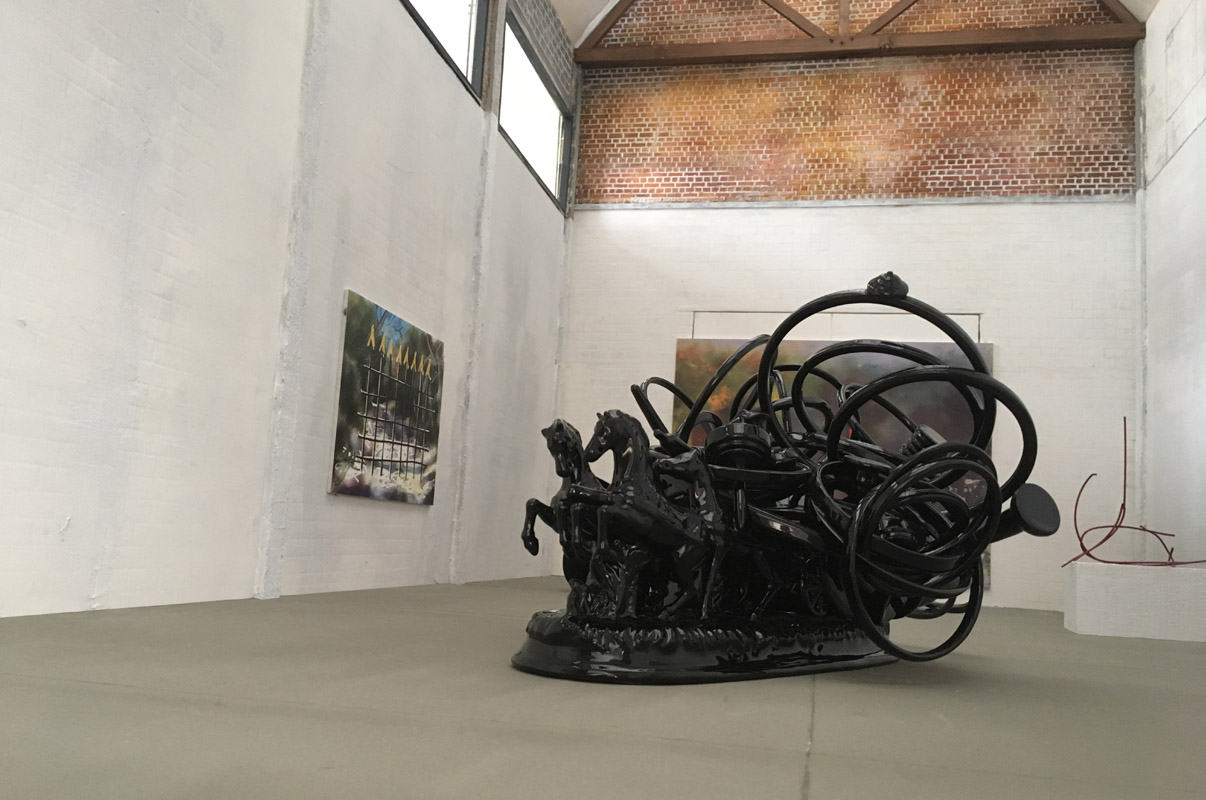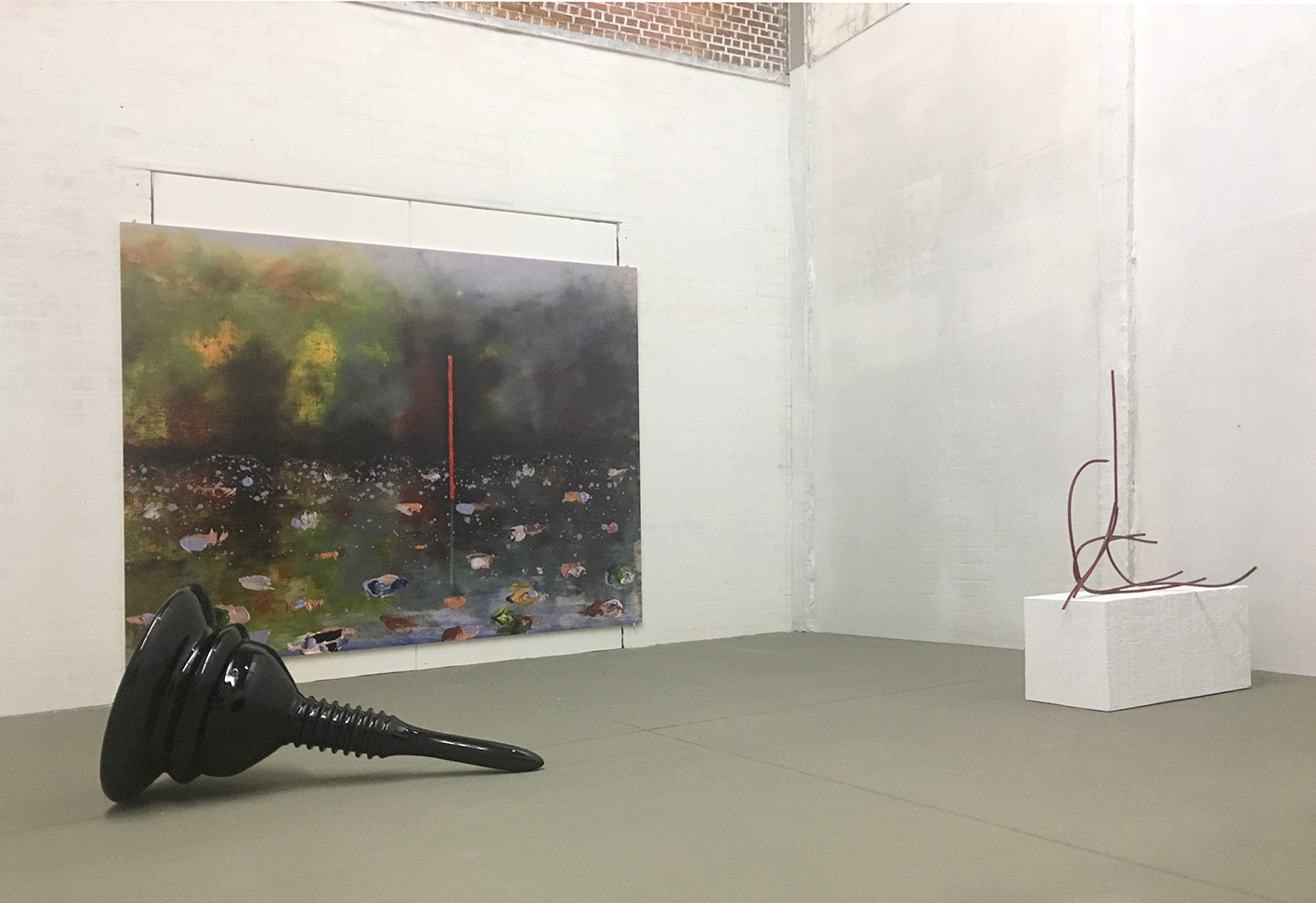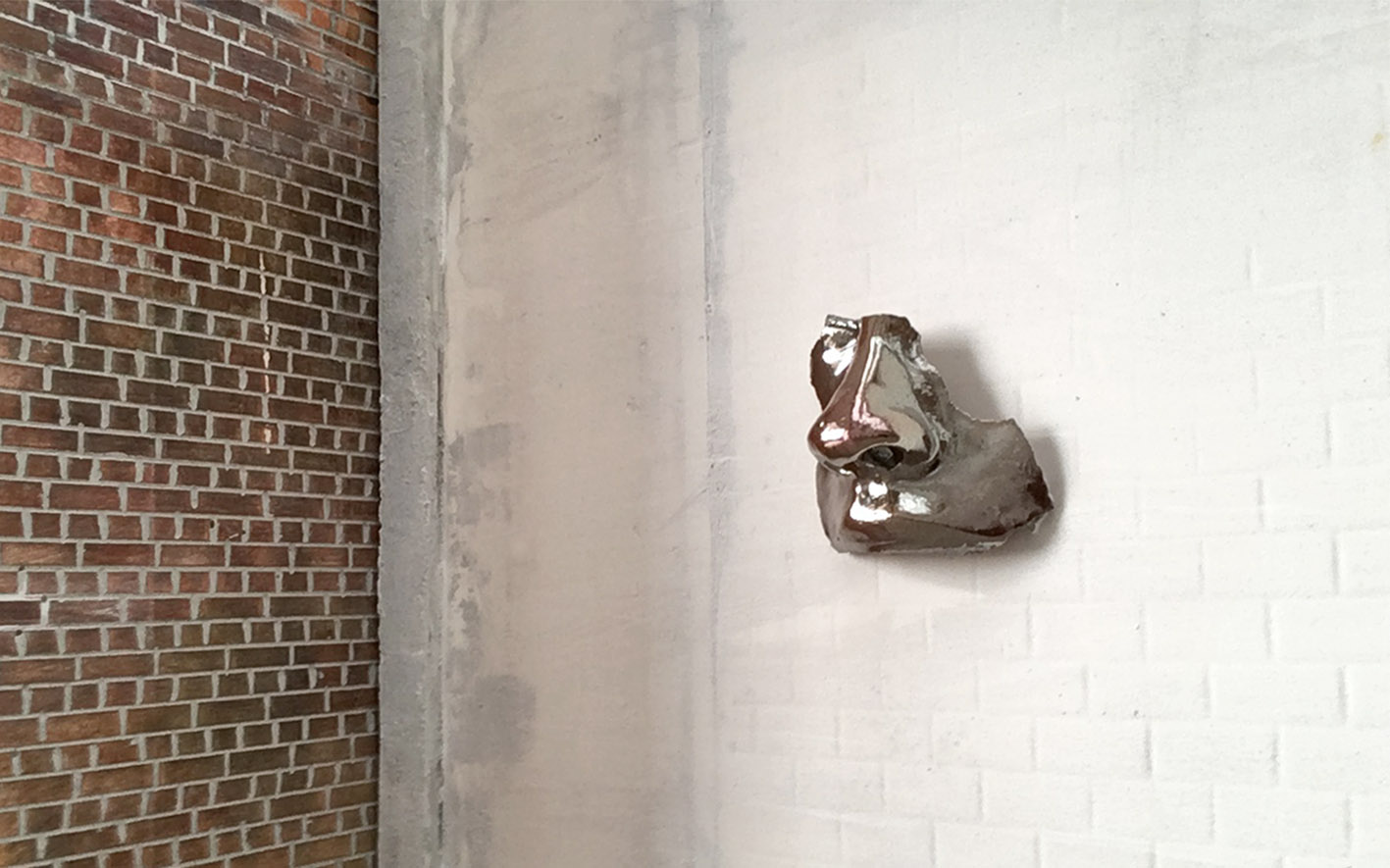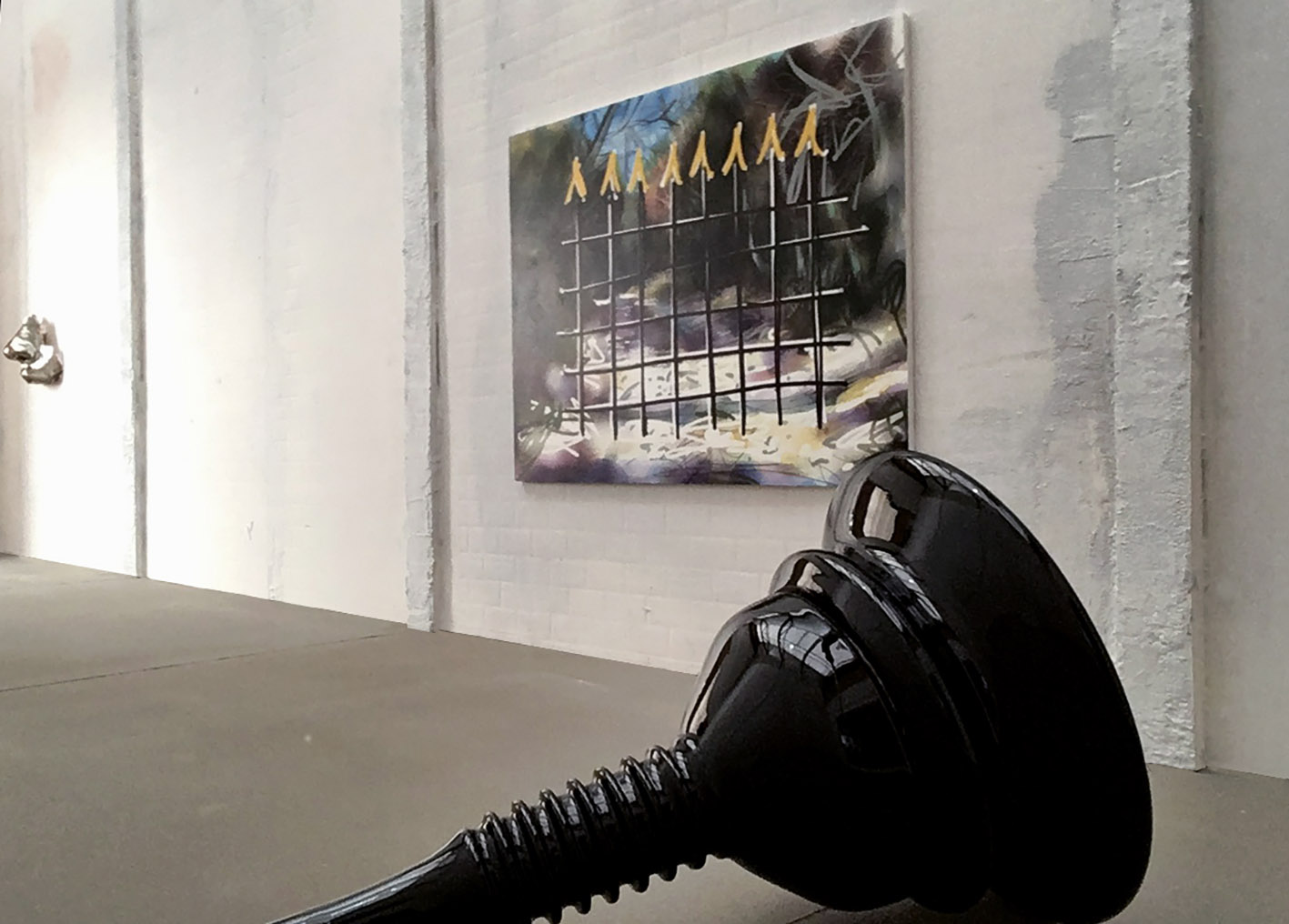Landschaft
Geometry in the landscape
Josh Berry - Fabien Boitard - Cathy Coëz
April 21 - June 10 2017






Il est 7h, le jour encore faible, des lignes scintillantes strient le ciel. Elles semblent immuables, éternelles. Quelques vents célestes, imperceptibles - si ce n’est par ces effets - dévient lentement leurs routes qui se dissipent en d’évanescentes formes.
Cet air de DCA, tellement banal aujourd’hui, n’existait pas il y a 50 ans. Il a supplanté les cirrus, les sycomores, la voie lactée et les rêveries bucoliques.
Au sol, des routes asphaltées décrivent d’interminables entrelacs que les chemins de fer traversent imperturbablement au rythme de l’activité humaine. En zone périurbaine, le paysage est un décor que l’on côtoie comme un travelling.
Le paysage, « landscape » en anglais, recouvre littéralement le territoire à perte de vue. Ce n’est pas surprenant pour des insulaires dont les frontières ne sont pas négociables. On retrouve cependant la même racine dans l’allemand « Landschaft » et le flamand « lantscape ». En France, région continentale et disputée, le « paysage » marque ce qui « paye ». Comme pour l’italien « paesaggio », le portugais « paisagem » et l’espagnol « paisaje », le pays est considéré selon certaines dispositions politique ou administrative qui accordent et essayent l’assiette d’imposition. Il est un territoire comptable. S’il se confond souvent avec un circuit fluvial, c’est que les cultures ont besoin d’irrigations et de limites. Il est alors couvert d’enclosures, de bocages, de parcelles, qui sont autant de subdivision de propriétés et de pouvoirs. En temps de paix, il est exploité par le paysan. En cas de conflit, il devient le théâtre des « opérations » qui détruisent cette arithmétique, puis en établissent une nouvelle.
La représentation traditionnelle met en valeur cette parcellisation aux effets chromatiques tellement picturaux - selon les cultures et les saisons.
Il n’y a pas de lignes droites naturelles. Un trait, un alignement, une tâche sombre indiquent que la terre a été récemment travaillée - en zone frontalière c’est une menace - avertie le démineur.
Par intérêt ou par raison, l’humain impose ses formes qui contrarient l’environnement. Dans la nature, une droite ne négocie pas. Elle lutte contre les courbes topologiques, contre les fluctuations climatiques, contre la vie. Elle coupe, traverse, tranche le nœud gordien des écosystèmes. Dans la nature, la géométrie est un concept violent que le cerveau utilise comme un piège.
La chose est ancienne, très certainement, dans l’esprit humain. Mais les moyens de sa réalisation technique à grande échelle sont indiscutablement le fait de la machine. Au cours du XIXème siècle, l’industrie produit en quantité quasi infinie les outils et la matière de ces cloisonnements qui transforment l’environnement sauvage en fraction d’activité économique. L’architecture brise ainsi l’état d’harmonie contemplative du paysage naturaliste. Elle impose son ordre.
Une pyramide, une éolienne, un aqueduc, quel que soit le degré de perfection esthétique qu’on leur attribue, s’approprient un territoire par la rupture visuelle qu’ils provoquent. Ils sont les relais d’un pouvoir, et leur dogme ne s’adapte pas aux contingences.
L’irruption des structures géométriques dans le « Landschaft » immaculé est un paradigme d’abstraction récent. Celui-ci n’existant pas davantage qu’une pensée qui n’aurait déjà été pervertie par le calcul, nous dirons de cette représentation asymétrique qu’elle témoigne d’une rupture irréversible avec la réalité terrestre considérée comme contingence-originelle. L’homme ne sait plus davantage vivre avec la nature que la nature avec l’homme. L’alliance est rompue depuis longtemps, certes, mais cette perte n’est visible et inquiétante que depuis peu.
Un concept se superposant à lui-même perd pied, il ressemble aux phantasmes d’absolu qui bâtissent eux-mêmes les conditions de leur chute.
—
It is 7 am; the daylight is yet weak, glistening lines streak across the sky. They look immovable, eternal. As a celestial breeze, almost imperceptible – even if its effects are not – slowly show the routes they take as they dissipate, slowly, into evanescent shapes.
Air-conditioned air - this manufactured air which is a part of everyday life now didn't exist 50 years ago. It has supplanted the cirrus clouds, sycamore trees, the Milky Way and our rustic musings.
On the ground, the tarmacked roads, endlessly interlaced with interminable railways which crisscross with the constant rhythm of human activity. In suburbia, a countryside is merely a form of décor with which one lives sideby-side like a panoramic tracking shot.
The countryside, or 'landscape' in English, literally describes the territory as far as the eye can see. This is of no surprise given the fact that these islanders have borders that are non-negotiable. We also find the same root in the German word 'Landschaft', the Flemish, 'landscape.' In France, continental boundaries are a matter of dispute, the 'paysage' – denotes that this is something with a price. This is a territory with a price. If it is often confused with a riverine circuit, culture too needs irrigation and limits.
It is covered with enclosures, groves, plots, which are too, a system of subdivision of property and power.In times of peace, it is exploited by the country dweller. In times of conflict, it becomes a theatre of 'operations' which destroy this arithmetic all the while establishing a new order. Traditional representation emphasizes this chromatic, highly visual, fragmentation of the land – depending on culture and seasonality.
In nature, there are no straight lines. This sign, alignment, a severe task showing that the earth has recently been worked – in border areas, it is a threat - warn the deminers.
Motivated by interest or reason, humans impose their own forms in opposition to the natural environment. In the natural world, lines are non-negotiable. They fight against the topological curves against climatic fluctuations, against life itself. It cuts, divides, chops off the gordian knot of ecosystems.
In the natural world, geometry is a violent concept that the human brain deploys like a trap. This ancient concept is so fundamental to human nature. However, the means through which this is used; technical, large scale, is indisputably the work of the machine. During the 21st century, industry produced, in almost infinite quantities the tools, the materials for this compartmentalization which transforms this wild environment into a space of ordered economic activity. Thus, the architecture breaks the state of contemplative harmony of the naturalistic landscape. Imposing its own order.
A pyramid, a wind turbine, an aqueduct, no matter how aesthetically perfect they are considered to be, they appropriate the landscape through the visual rupture they cause. They are demonstrations of power, and their dogma does not adapt to contingencies.
The eruption of geometric structures in the immaculate "Landschaft" is a paradigm of recent abstraction. This exists only as an after-thought which should not have entered into the calculation; we see this asymmetrical representation as playing witness to an irreversible rupture with the natural world, considered only as a contingency plan. Man no longer knows how to live with nature nor nature with man. This alliance was broken long ago, of course, but this loss cannot be seen and is worrying.
A concept superimposed on itself loses its footing, it begins to resemble the ghosts of the absolute, the constructors of their own downfall.